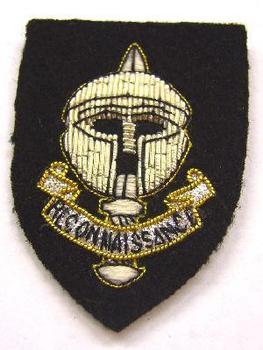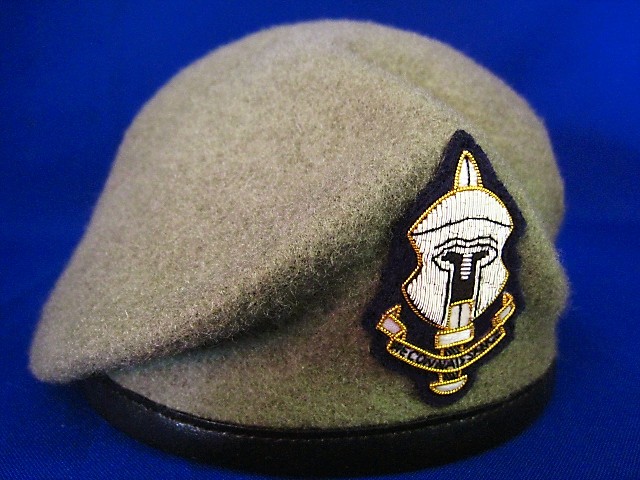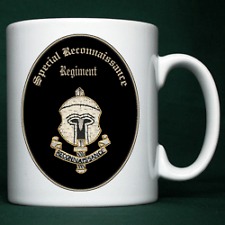PART ONE: INTRODUCTION
1.0 Background
On 05 April 2005, the then Secretary of State for Defence, Geoffrey Hoon, announced that the Special Reconnaissance Regiment (SRR) would stand up on 06 April 2005 (Hansard, 2005). Although the ceremony took place at the Royal Military Academy of Sandhurst (RMAS), the SRRs Headquarters (HQ) is in South Wales (Rayment, 2005).
The formation of the SRR, a Tri-Service unit administered by the British Army, was a result of the Strategic Defence Review (SDR) A New Chapter published in July 2002 in which the UK Government formulated plans to enhance and build upon the capabilities of the United Kingdom’s Special Forces (UKSF).
As such, the SRR was formed to meet a growing worldwide demand for special reconnaissance capability by providing improved support to expeditionary operations overseas and form part of the defence contribution to the Government’s comprehensive strategy to counter international terrorism.
Due to the specialist nature of the unit, it fell under the command of the Director Special Forces and is a part of the UKSF group. It is the first new SF Regiment since the 1950s and has an establishment of 300-400 personnel (Harding, 2005; Scotsman, 2005), 500-600 personnel (Heyman, 2005) or 700 personnel (Giannangeli, 2012) taken from existing units.
 1.1 Aim
1.1 Aim
The aim of this article is to describe the background, role and organisation of the SRR, as well as outline the selection process and highlight some of the terms and conditions of service where they differ from the wider-Services.
1.2 Women and the SRR
In accordance with current Government policy on the employment of women in the UK, military service in the UKSF is only open to male volunteers. However, appointments do exist for women within the UKSF Group; as such women can apply for the SRR and as support staff.
The first female operators served with the Special Operations Executive in the Second World War but it is the 30-year conflict in Northern Ireland that showed how effective women operatives could be against the IRA (Giannanegli, 2012).
On 08 July 2016, the MOD announced that all Ground Close Combat Roles (RAC, Infantry, Royal Marines and the RAF Regiment) would be opened to women by 2018 (British Army, 2016).
PART TWO: ROLE AND ORGANISATION
2.0 Role of the SRR
The role of the SRR is to identify human targets, through surveillance and infiltration teams, so that they can be attacked and eliminated by other units such as the Special Air Service (SAS) and Special Boat Service (SBS).
The SRR was formed to relieve the SAS/SBS of the surveillance role. The SRR operates around the world, working closely with MI5, MI6 and foreign intelligence organisations.
2.1 Organisation of the SRR
The SRR brougth together personnel from existing capabilities (e.g. 14 Intelligence Company, see below) and became the means of the further development of the capability. Although another source (Sengupta, 2009) suggests “…the core membership is drawn from 1st Battalion, The Parachute Regiment and Signals Regiment…”
2.2 14 Intelligence Company
The SRR was formed around a core of already existing assets, thought to be an allusion to the Joint Communications Unit (Northern Ireland) (JCU(NI)), known in popular culture as 14 Intelligence Company (14 Int) or the Detachment (Det), which performed a similar role against Irish republican and loyalist terrorism in Northern Ireland since the 1970s.
The SRR absorbed 14 Int incorporating the surveillance skills learnt by 14 Int, the SAS and other units over decades of carrying out close target reconnaissance missions in enemy territory.
The detachment, which is still operating in Ulster and the Balkans, recruited men and women from all three Services and at its height 14 Int numbered about 200 troops.
PART THREE: OUTLINE OF THE SRR SELECTION PROCESS
3.0 Eligibility
Nothing of real value has been released into the public domain regarding recruitment and selection, but enough has been released to give an approximate outline. However, predicated around the JCU(NI) model, the SRR is open to all male and female officers and other ranks, up to the age of 32, from the three Services (Rayment, 2005) who have completed all Phase 2 (employment) training associated with their career employment group (CEG or Service equivalent).
3.1 Medical Standard
Candidates should have a minimum medical classification as per JSP 950 ‘Medical Policy’ (published 01 April 2011, formerly JSP 346). Candidates should also refer to the relevant DIN (Defence Instructions and Notices) as published by the Sponsor Branch (HQ Directorate of Special Forces).
3.2 SRR Briefing Course
In order to inform potential volunteers about the opportunities available as an Operator within the SRR, the Regiment runs a series of Acquaint Days which are located in Hereford and last one day. These events are structured to provide a number of practical events and informative briefs giving aspirants the opportunity to gain further insight to life within the SRR.
 3.3 SRR Selection Course
3.3 SRR Selection Course
Although the early phases of training are be based on the UKSF Selection process, with SAS instructors (Norton-Taylor, 2005), the main training will be very different.
Candidates undergo an initial assessment before being called for a gruelling eight-week selection process involving physical, mental and academic tests undertaken at remote bases on Dartmoor, in Wales and Scotland. Although Harding (2005) suggests the selection course is equivalent to the Para’s ‘P Company’ and candidates are trained by the SAS in close quarter battle (CQB). Rayment (2005) on the other hand suggests that candidates must complete a gruelling six-month selection course and women undertake exactly the same physical and mental tests as their male counterparts. However, the 2013 edition of the JSP 754 Tri-Service Regulations for Pay and Charges Chapter 5 Section 5 on page 5-5-2 states: “Volunteers retain their existing rates of pay throughout the 26 week training phase (28 weeks for SRR).”
Operatives (or Operators), as they are known, are trained in the SRRs core disciplines before being given the opportunity to acquire highly specialised skills. These skills include covert surveillance, CQB skills, self-defence and driving skills. They are also taught how to plant bugging devices, hidden cameras and covert methods of entry into buildings and cars (Rayment, 2005). Arabic and other Middle East language skills are also a top requirement for the candidates, allowing them to blend into Islamic societies on undercover operations, which they would undertake at the Defence Centre for Languages and Culture (which sits within the College of Management and Technology, which is part of the Defence Academy of the United Kingdom (DAUK) located in Shrivenham, near Swindon). The SRR also employs state-of-the-art electronic surveillance gear to eavesdrop on their targets.
The nature of employment generates a quietly professional culture in which teamwork, integrity and discretion form a key part.
3.4 Course Dates
The original DIN (Defence Instructions and Notices) 2005 02-025: Volunteers for the Special Reconnaissance Regiment contained the information required to apply for the SRR. This DIN is updated annually and is available to serving UK military personnel only.
PART FOUR: TERMS AND CONDITIONS OF SERVICE
4.0 Uniform
The unit usually conducts its operations in plain clothes and wears uniform only in barracks or for formal parades (Rayment, 2005).
 Additionally, personnel retain the uniforms of their parent organisations with the addition of an ’emerald grey’ coloured beret and the SRR cap badge. The cap badge of the SRR is described as “Argus helmet in front of the Special Forces sword with motto scroll ‘Reconnaissance’ underneath”. The Special Forces sword refers to that represented in the design of the Special Air Service Regiment badge though pointing upwards. Although the sword in the Special Air Service Regiment badge is often incorrectly referred to as the “winged dagger”, the original intent of the designer (reputedly Bob Tait) was a representation of King Arthur’s sword Excalibur.
Additionally, personnel retain the uniforms of their parent organisations with the addition of an ’emerald grey’ coloured beret and the SRR cap badge. The cap badge of the SRR is described as “Argus helmet in front of the Special Forces sword with motto scroll ‘Reconnaissance’ underneath”. The Special Forces sword refers to that represented in the design of the Special Air Service Regiment badge though pointing upwards. Although the sword in the Special Air Service Regiment badge is often incorrectly referred to as the “winged dagger”, the original intent of the designer (reputedly Bob Tait) was a representation of King Arthur’s sword Excalibur.
FOI Request: 20150210-FOI00908_74397_Marshall_SRR_Cap_Badge_Response
In the case of the SRR, the sword being placed behind a Corinthian-style helmet (favoured by the ancient Greeks from the early 7th to 4th centuries BC), surmounting a scroll inscribed RECONNAISSANCE (Harding ,2005). The helmet faces forward and suggests “the viewer is being watched while the wearer behind the mask is anonymous.” (Harding, 2005).
The stable belt of the SRR is similar in style to that of the SAS, however is darker in appearance, being midnight blue.
4.1 Rank and Promotion
Senior Ratings, Warrant Officers and Non-commissioned Officers (NCOs) volunteering for service with UKSF will not have the experience or ability to serve in UKSF in their existing rank (although they may merit promotion within UKSF in the future). As a consequence, they will initially serve in the rank of Trooper (OR-2) on joining 22 SAS/SRR or Marine (OR-2) for SBS and their substantive military rank will be placed in abeyance until superseded by SF worn rank or they are accepted for the UKSF Permanent Cadre. Seniority in their substantial Service rank will continue to accrue and those returning to their source specialisation on completion of their first or second tour with UKSF will return in line with their accrued seniority. Rules for subsequent promotion whilst serving with UKSF are contained in the relevant DIN.
The CO SBS and CO 22 SAS, in consultation with HQ Directorate of Special Forces and the relevant Service manning authority, may select personnel seconded to SBS/SAS for acting promotion in UKSF units.
4.2 Shadow Rank
A ‘shadow rank’ is created which tracks an individual’s normal career path in their parent unit, including incremental base dates and promotion boards, so as not to disadvantage the individual should they return to normal duties in the future.
4.3 Pay
The regulations for recruitment and retention pay, previously known as additional pay or Special Forces pay, are laid down in JSP 754 Tri-Service Regulations for Pay and Charges Chapter 5 Section 5 and Chapter 6 Sections 12 and 15. The rates of SF pay payable are determined by an individual’s SF rank and time in rank.
Individuals retain their existing rates of pay throughout the 26-week training phase (28-weeks for SRR). On completion of their training, badging day, personnel enter the SF in the rank of Trooper for the SAS and SRR, or Marine for the SBS, and transfer to the SF Pay Spine, Range 1 (OR-2), incremental level 1 (IL1). Where SF Pay plus (RRP) (Section 9.9) is less than the current rate of pay, individuals will be placed on to a Mark Time Rate of Pay (MTRP) for two years or the period of conversion training, whichever is the greater.
The UKSF pay spine is set at a higher rate of pay for each rank than the normal rates set for the remainder of the UK military.
4.4 Seniority and Incremental Progression
SAS, SBS and SRR seniority for pay and yearly incremental progression (YIP) is assessed as SF seniority only, commencing on badging Day, and only include time spent on SF duty. YIP rules will otherwise be in accordance with JSP 754 Chapter 3 Section 4. Note there is no scope for accelerated incremental progression (AIP) for SAS/SBS/SRR personnel.
4.5 Recruitment and Retention Pay
The type of recruitment and retention pay (RRP) an individual receives is dependent on whether the individual is SAS/SBS or SRR:
- For SAS/SBS personnel: RRP (Special Forces) (RRP(SF));
- For SBS personnel with the SDV additional qualification (adqual): RRP (Special Forces Swimmer Delivery Vehicle Troop) (RRP(SF-SDV))
- For SRR personnel: RRP (Special Reconnaissance) (RRP(SR)).
The level of RRP is based on the number of bounty earning years since badging day. In addition to the appropriate level of RRP(SF), qualified personnel of all ranks filling established posts in the Swimmer Delivery Vehicle Troop will be eligible for the payment of RRP(SF-SDV)
 4.6 Personnel Returning to Normal Duties
4.6 Personnel Returning to Normal Duties
On return to normal duties:
- SAS/SBS/SRR personnel who have not attained UKSF Permanent Cadre status will transfer back to the normal pay range based on their shadow rank and seniority. Personnel whose SAS/SBS/SRR rank on return to normal duties is higher than their shadow rank, will be assessed for rank and seniority by the receiving manning authority, and will have their pay assessed accordingly by the Joint Personnel Administration Centre (JPAC).
- SAS/SBS/SRR Permanent Cadre personnel, who no longer hold a shadow rank, would be assessed for rank and seniority by the receiving manning authority, and will have their pay assessed accordingly by JPAC.
4.7 Disclosure Contract
Due to the sensitive nature of their employment all personnel volunteering for UKSF are to be aware that they will be required to sign and abide by a confidentiality contract. Refusal to comply will result in an individual being deemed unsuitable for employment in SF. Full details of the provisions and conditions of the Disclosure Contract are given at UKSF briefings.
PART FIVE: MISCELLANEOUS
5.0 Summary
UKSF is open to all male officers and other ranks of the UK military. UKSF seeks to attract determined, highly-motivated, intelligent, reliable and physically fit individuals to serve with both the SAS and SBS. This article provides the basic information to allow individuals to make an informed judgement before applying for UKSF Selection.
5.1 Useful Documents
- JSP 754 Tri-Service Regulations for Pay & Charges (2013-10-01):
- Chapter 5, Section 5
- Chapter 6, Section 15
5.2 References
Giannangeli, M. (2012) A Secret Army of ‘Amazons’ Guards Olympic Games. Available from World Wide Web: http://www.express.co.uk/news/uk/334450/A-secret-army-of-Amazons-guards-Olympic-Games. [Accessed: 24 July, 2014].
Hansard (2005) Written Ministerial Answers: Special Reconnaissance Regiment. Available from World Wide Web: http://www.publications.parliament.uk/pa/cm200405/cmhansrd/vo050405/wmstext/50405m01.htm#50405m01.html_sbhd5. [Accessed: 24 July, 2014].
Harding, T. (2005) New Special Forces Unit Will Spy on the Terrorists. Available from World Wide Web: http://www.telegraph.co.uk/news/uknews/1487233/New-Special-Forces-unit-will-spy-on-the-terrorists.html. [Accessed: 24 July, 2014].
Heyman, C. (2005) New Regiment Will Support SAS. Available from World Wide Web: http://news.bbc.co.uk/1/hi/uk/4414339.stm. [Accessed: 24 July, 2014].
Norton-Taylor, R. (2005) New Special Forces Unit Tailed Brazilian. Available from World Wide Web: http://www.theguardian.com/uk/2005/aug/04/july7.menezes. [Accessed: 24 July, 2014].
Rayment, S. (2005) Army Reveals Secret Elite Unit That Puts Women On Front Line. Available from World Wide Web: http://www.telegraph.co.uk/news/uknews/1497590/Army-reveals-secret-elite-unit-that-puts-women-on-front-line.html. [Accessed: 24 July, 2014].
Scotsman (2005) New Special Force Targets Terror. Available from World Wide Web: http://www.scotsman.com/news/uk/new-special-force-targets-terror-1-706756. [Accessed: 24 July, 2014].
Sengupta, K. (2009) Special Forces Deployment in Northern Ireland May Have Sparked Assault. http://www.belfasttelegraph.co.uk/news/local-national/special-forces-deployment-in-northern-ireland-may-have-sparked-assault-28469854.html. [Accessed: 24 July, 2014].
British Army (2016) Ground Close Combat Roles Open To Women. Available from World Wide Web: http://www.army.mod.uk/news/28632.aspx. [Accessed: 08 August, 2016].






Hi. I’m in the Navy and completed phase 2 training. We had a brief on the SRR and I am determined to join. Is there any other information you have on the parameters for joining. I heard that no visible scars or defined features are wanted with candidates.
Thanks.
Hi David,
Look up the latest DIN on the Defence intranet for the precise parameters on joining.